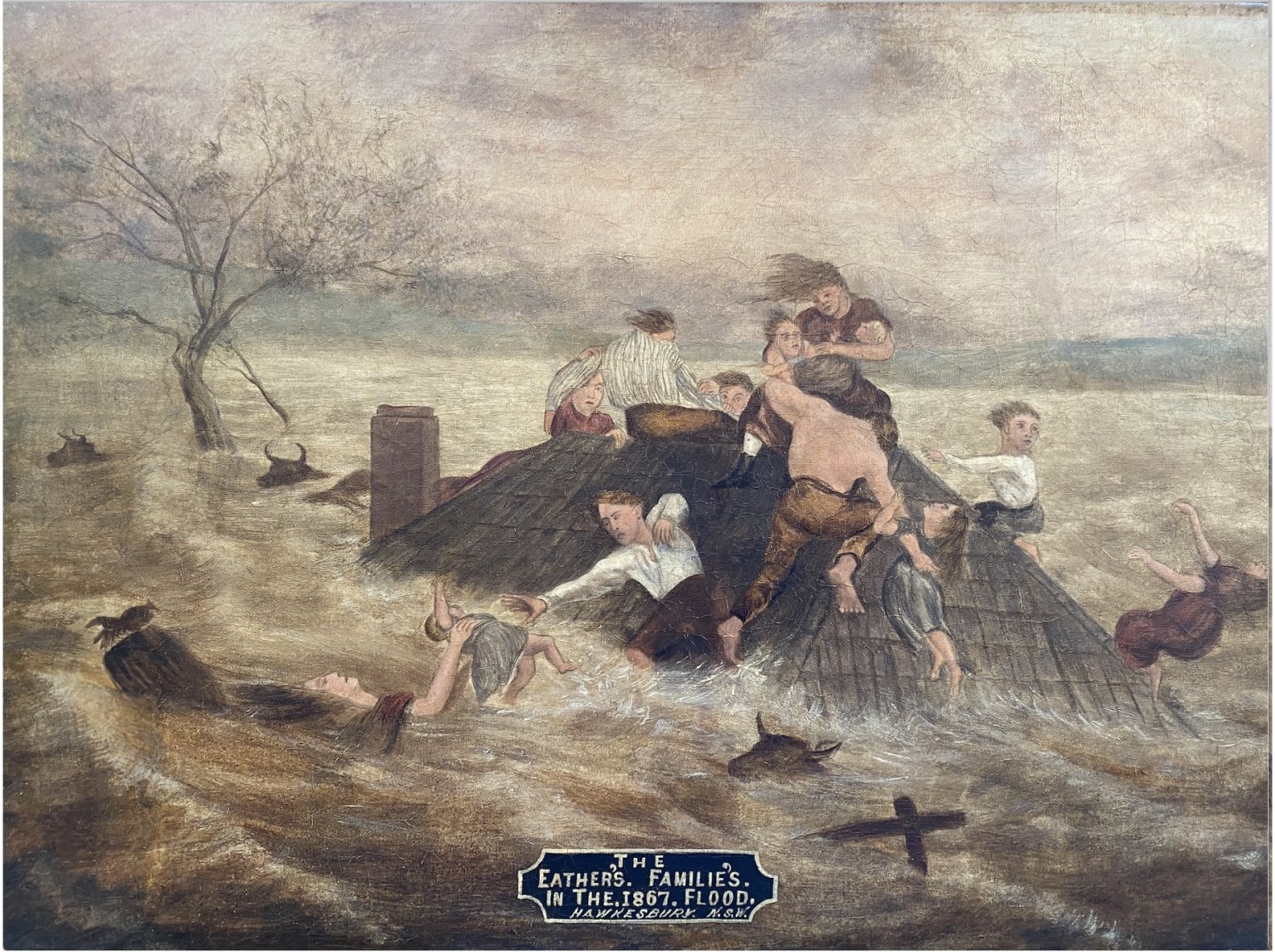Unknown Colonial Artist
The Eather families in the 1867 flood, Hawkesbury River, N.S.W
Oil on canvas
Inscribed lower centre: ‘THE/EATHER’S [sic] FAMILIE’S [sic]/ IN THE 1867 FLOOD/HAWKESBURY. N.S.W.
41.2 x 58.2 cm
SOLD
Provenance:
Possibly George Eather, then to Dora Eather (widow of George – see reference to the painting of the flood in the 1912 Nepean Times article below); unknown; private collection, Launceston, Tasmania, to 2018; private collection of Jim Berry and Stephen Scheding, Sydney, and gifted by them to the State Library of New South Wales.
This painting relates to the engraving that appears in the Illustrated Sydney News, 16 July, 1867, titled Flood on the Hawkesbury - the drowning of the families of William and Thomas Eather, 1867 (reproduced below). According to Peter A. Dowling in Index to Imagery in Colonial Australian Illustrated Newspapers (2012) the image was engraved by A. L. Jackson after an ‘illustration’ by Eugene Montagu Scott. Montagu Scott contributed many illustrations and cartoons to Australian newspapers and demonstrated skills in a wide array of materials, including oils, and styles (see Design & Art Australia Online).
When George Eather, the surviving brother of William and Thomas Eather, died in 1912 the Nepean Times (25 May 1912. Page 3) interviewed his widow, Mrs Dora Eather, and reported that ‘Mrs Eather showed us yesterday an old painting depicting the flooded families desperately clinging to the roof of the house.’ It is likely that this refers to the painting being offered here. The full article with the interview with Dora Eather is below.
The flood of June 1867 is one of the most significant natural disasters to hit the Hawkesbury Nepean region. The town of Windsor was almost entirely submerged and floodwaters reached up to nearly 20 metres high. Twenty people died, including 12 members of the extended Eather family.
The Eather brothers William, Thomas and George, lived by the Hawkesbury river at Cornwallis, known locally as the 'Bottoms' (low lying land between the Hawkebury River and Rickaby's Creek). It is the families of William and Thomas who are tragically depicted in the painting. They had taken shelter on George's house on the 20th of June, 1867. However, on the 21st of June, before a rescue boat could get to them, the house collapsed, sweeping the wives and 10 children away. Lost were William's wife Catherine and all five of their children – Mary Anne (aged 11), Charles (aged 9), Catharine (aged 6), Clara (aged 3) and William (aged 1). Thomas likewise lost his wife Emma and five of their six children - Annie (aged 14), James (aged 11), Elizabeth (aged 11), Angelina (aged 5) and Emma (aged 2). Only one of Thomas' children, Charles Frederick Eather (1851-1885) survived. William, Thomas and his son Charles Frederick were able to cling on to the trees.
Only six bodies were recovered at first. The body of James Eather was found a couple of days after the flood, while the body of eight-year-old Elizabeth was found two months later. The remaining bodies were never recovered.
From Nepean Times, 25 May 1912. Page 3:Death of Mr George Eather - At Richmond (The '67 Flood)
Mr George Eather, of Lennox street, Richmond, aged 77, passed away last Thursday week. Deceased was one of the good old Hawkesburyites whom everyone respected. He leaves a widow (also in the seventies) and a surviving family of eight out of 18 as follow:-Mrs Carr, South Africa; Mrs Chas Baldwin, Durham Court, Manilla; Mrs A McNiven, Sydney; Mrs R Fay, Eskbank; Miss Maggie Eather, Richmond; Mr Walter Eather, Sydney; Mr James Eather, Sydney; and Mr Ambrose Eather, Brewarrina. The latter, who had not seen his father for eleven years, came home and spent the last five weeks with him. The remains were laid to rest on the Saturday following in the new Roman Catholic cemetery, the Rev Father O'Brien officiating. The. funeral was largely attended, some very old and esteemed friends being in the procession. For 26 years the late George Eather occupied the farm where Mr W Day now resides. He vacated it about ten years ago. He led a quiet life. An outstanding feature in his long career, however, was his awful experience, in the historic flood of '67. Most of our readers have heard or read something of the drowning of the Eathers. It was in June of the year mentioned. Mrs Eather showed us yesterday an old painting depicting the flooded families desperately clinging to the roof of the house down on the flats of Corn Wallis. The waters crept up until only three rows of shingles were out. Then, the roof collapsed, and twelve were drowned. “It was a new slab house, just built for us,” Mrs Eather explained, “and when .the waters began to rise, we regarded it as the best shelter. My brother-in-iaw, Johnny Madden, came down on the Wednesday. He had a lot of pigs in another paddock on the river bank, and tried to get them away. Some men were also about, attending to odd things on the farms, after taking the cattle up, but the water overflowed the flats, and they were cut off. George Cupitt was taking them back in a boat, and Johnny said to me, 'You had better go up in the boat to your sister's, and take the four children.' At first I refused, saying I would have to bake some bread and get everything on to the; loft before morning. However, he prevailed upon me to go. My husband stayed. When we were getting into the boat, Tom and Bill Eather came over, with their families, to take refuge in our place. Mrs Bill Eather said, 'You won't forget us if the water comes over the ridge?' I wanted her to come too, but she would not. I also urged Mrs Tom to come, but no... She said she would if there was an empty house up in Clarendon to go to. We were pulled away at 4 in the afternoon. That night the flood rose fast. In the morning my sister (Mrs Smith) and I came into Richmond, and tried in vain to get a boat sent over. All day long we walked backwards and forwards in great anxiety. At night we went back to Clarendon. About 7 o'clock I saw a signal light away over the water, in the direction of our place, and I said, 'It is still them on the roof.’ We put rags and paper on the end of a fishing rod, lit them, and answered the signal.' Then I heard their cries. I rushed down to a man with a boat, and told him. A dozen men were standing round, but none offered to go. It was dark and raining. Dight's coachman, Riley, came along, and when we told him of our trouble he went to Mr Dight, who sent him galloping away with a note to Tierney to press the public boat when it came to shore, and offer the crew £50 to go back and get the boat and save those at Eather's. The boat was got about 10 o'clock, and three men offered to go out. To help them to steer across a fire was lit at Mr Dight's. They reached the place just about half an hour too late. Though, the house, of slabs, was built, strong, to withstand the floods, the roof had not been strapped, and it collapsed. Mrs Tom Eather and five of her children and Mrs Bill Eather and her five were drowned. Madden and. the brothers Tom, Bill and George Eather swain to a tree near by, from which the boat rescued them. Bill was strapped to the tree, in a state of collapse, and it was with difficulty he was afterwards resuscitated. Tom's eldest son, Charlie, was with Bill Bailey on the next farm, hanging on to a big willow tree, and they were rescued by the same boat. It was a long pull to where the fire was kept going - as a guide. Very quietly they came, for they thought Bill was dying in the boat. I could hardly realise it - when I saw my husband and the other survivors, but the drowning of the two wives and their ten children was a terrible blow." It might be added that Mr Tom Eather, sen., one of the survivors mentioned, now over 80 years old, was in Richmond a few days before the death of poor old George.
(Family information has been provided by Sarah Stavely, a descendant of the family, following conversation with Stephen Scheding, October, 2020. Sarah’s 3rd great grandmother Elizabeth Dodd married William Eather (1833-1899) at Richmond on September 2, 1869. Information also from ‘Remembering the great Hawkesbury flood tragedy of 1867’ ABC Radio Sydney, by Amanda Hoh, posted online Thursday 22 June 2017).




